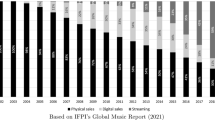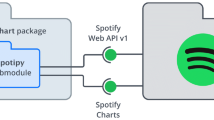“Cross-marketing is an age-old concept. As far back as Aerosmith and Run-D.M.C. or even before, there was the idea of, we’ll get some of your fans, you get some of our fans.”
Ricky Reed (artist, writer and producer), Nov. 30, 2017.
Abstract
Over the last 30 years, there has been an increasing tendency for artists to collaborate with ‘feature’ artists on one-off song projects. Although there might be purely artistic reasons for such collaborations, it is not clear a priori if there are also economic returns in terms of increased demand. Furthermore, if there is evidence of increased demand, the natural question becomes whether the mechanism is through a ‘quality’ or ‘promotion’ channel, or a combination thereof. Using weekly US Spotify streaming data from 2017–2018, we investigate these questions. We exploit the fact that many artists in our sample sometimes work alone and sometimes work with feature artists. Additionally, we also exploit the fact that many artists work with multiple features artists, which allows us to examine how (observed) feature artist characteristics affect demand. We find that songs featuring other artists generally outperform songs without feature artists, although there are a number of caveats with respect to the characteristics of the artists involved. Although we do not entirely rule out a quality effect, we conjecture a promotion effect is the primary channel explaining our main result.





Similar content being viewed by others
Notes
For example, The Temptations 1964 hit ‘My Girl’ was written by emerging Motown star Smokey Robinson, who also performed on the recording of the song. As a similar example, Rolling Stones frontman Mick Jagger made an uncredited appearance on Carly Simon’s 1972 hit ‘You’re So Vain.’
DJ Khaled is a notable example of an artist that has fully embraced the featuring model. Between 2016 and 2019, he released three albums, with all 52 tracks containing at least one feature artist.
We omit ‘holiday’ songs as these fall outside the scope of our study.
We lose a small number of observations because of perfect collinearity with respect to artist nationality.
Song release dates were obtained from MusicBrainz (http://musicbrainz.org).
We ran additional tests to investigate this conjecture. First, the sample was partitioned to exclude songs less than ten weeks old. The ‘feature artist’ effect was observed to be statistically insignificant in this model. Second, we interacted ‘feature artist’ with the linear trend decay term. No significance was observed, which suggests that time does not play any role in the magnitude of the feature artist effect as compared to solo songs, ceteris paribus.
We apply Billboard’s genre classifications defined over six categories: 1) Country, 2) Dance/Electronic, 3) Latin, 4) Pop, 5) R&B/Hip-hop, and 6) Rock/Alternative.
Google Trends does not provide absolute search volume, rather only as a relative proportion over a defined period (https://trends.google.com/trends/).
In unreported results, we removed those artists who had only collaborated with one artist but find almost identical results to those described below.
In an extensive interview about his No. 6 Collaborations Project album, Ed Sheeran discusses a number of songs that he partially wrote then engaged collaborators to further develop. About collaborating this way he remarked: 'If you have a song that you think is good and you put someone on it that you think is amazing, it instantly makes the song incredible.' (Interview with Charlamagne Tha God, July 12, 2019). See https://www.youtube.com/watch?v=vBULxi0LxT4.
The average number of individual reviews per song was 233. We investigated removing songs with fewer than 50 individual reviews, but found no change in the results we report.
References
Aguiar, L. (2017). Let the music play? Free streaming and its effects on digital music consumption. Information Economics and Policy, 41, 1–14.
Aguiar, L., & Waldfogel, J. (2018a). As streaming reaches flood stage, does it stimulate or depress music sales? International Journal of Industrial Organization, 57, 278–307.
Aguiar, L., & Waldfogel, J. (2018b). Quality predictability and the welfare benefits from new products: Evidence from the digitization of recorded music. Journal of Political Economy, 126(2), 492–524.
Benner, M. J., & Waldfogel, J. (2016). The song remains the same? Technological change and positioning in the recorded music industry. Strategy Science, 1(3), 129–147.
Büyükboyacı, M., & Robbett, A. (2017). Collaboration and free-riding in team contests. Labour Economics, 49, 162–178.
Crosby, P., Lenten, L. J., & McKenzie, J. (2018). Social media followers as music fans: Analysis of a music poll event. Economics Letters, 168, 85–89.
Datta, H., Knox, G., & Bronnenberg, B. J. (2018). Changing their tune: How consumers’ adoption of online streaming affects music consumption and discovery. Marketing Science, 37(1), 5–21.
Ductor, L. (2015). Does co-authorship lead to higher academic productivity? Oxford Bulletin of Economics and Statistics, 77(3), 385–407.
Hiller, R. S. (2016). Sales displacement and streaming music: Evidence from YouTube. Information Economics and Policy, 34, 16–26.
Hollis, A. (2001). Co-authorship and the output of academic economists. Labour Economics, 8(4), 503–530.
Kretschmer, T., & Peukert, C. (2020). Video killed the radio star? Online music videos and recorded music sales. Information Systems Research, forthcoming.
Laband, D. N., & Tollison, R. D. (2000). Intellectual collaboration. Journal of Political Economy, 108(3), 632–662.
Lazear, E. (1998). Personnel economics for managers. New York: Wiley.
Lazear, E. P., & Shaw, K. L. (2007). Personnel economics: The economist’s view of human resources. Journal of Economic Perspectives, 21(4), 91–114.
Mas, A., & Moretti, E. (2009). Peers at work. American Economic Review, 99(1), 112–145.
Ordanini, A., Nunes, J. C., & Nanni, A. (2018). The featuring phenomenon in music: How combining artists of different genres increases a song’s popularity. Marketing Letters, 29(4), 485–499.
Wlömert, N., & Papies, D. (2016). On-demand streaming services and music industry revenues—insights from Spotify’s market entry. International Journal of Research in Marketing, 33(2), 314–327.
Wuchty, S., Jones, B. F., & Uzzi, B. (2007). The increasing dominance of teams in production of knowledge. Science, 316(5827), 1036–1039.
Acknowledgements
We thank participants of (i) 94th Western Economic Association International Conference, San Francisco (July, 2019); (ii) 5th Asian Workshop on Cultural Economics, Ho Chi Minh City (July, 2019); (iii) 8th European Workshop on Applied Cultural Economics, Copenhagen (September, 2019); (iv) 10th Music Business Research Days, Vienna (September, 2019) for comments. We also thank two anonymous reviewers and the editor for helpful comments that have improved the final manuscript. The authors are responsible for any errors.
Author information
Authors and Affiliations
Corresponding author
Ethics declarations
Conflict of interest
The authors declare that they have no conflict of interest.
Additional information
Publisher's Note
Springer Nature remains neutral with regard to jurisdictional claims in published maps and institutional affiliations.
Rights and permissions
About this article
Cite this article
McKenzie, J., Crosby, P. & Lenten, L.J.A. It takes two, baby! Feature artist collaborations and streaming demand for music. J Cult Econ 45, 385–408 (2021). https://doi.org/10.1007/s10824-020-09396-y
Received:
Accepted:
Published:
Issue Date:
DOI: https://doi.org/10.1007/s10824-020-09396-y




